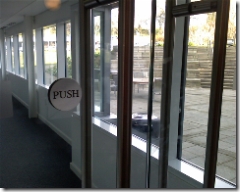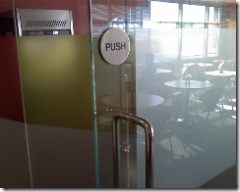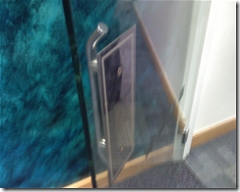The Design of Everyday Things
In part 2 of my book post about design (part 1 was earlier this week), I'll revisit an old title which is still great reading for anyone interested in cognitive theory or design. It was written by Donald Norman, and first published nearly 20 years ago as "The Psychology of Everyday Things". The author found that bookshops & libraries tended to lump the book in with all the psychology textbooks, so a later edition was re-released under the modified title of the Design of Everyday Things.
The book itself looks at lots of good examples of where a designer has clearly thought about a problem and taken account of it in the design, but the more interesting (to me, at least) cases are where the usability of a system is so totally shot just because the designer didn't take a simple thing into account.
Examples of the kinds of scenarios that Norman deals with are cookers where the layout of controls for the burners is different to that of the burners themselves (eg the burners are 2 x 2 but the controls are in a line of 4 - very common) or light switches which seemingly bear no resemblance to the layout of the lights they operate. I've lived in houses for years, and still kept getting the switches in the hall round the wrong way, so I know where he's coming from there. In fact, in my house right now, the left hand switch operates the lights at the right side of the room and vice versa - I really must get round to rewiring that switch one day.
My favourite examples in the book are of the humble door, however. Here are some example photos I've taken on a camera phone (my new Orange E600, a version of the HTC S620 which Darren recently raved about).
The first 2 pictures are of a fire door in Microsoft UK's TVP campus; the point about design here is that there are no instructions on the door about what to do. If you walk up to a fire exit door, for example, and it has a horizontal bar across it, you would be drawn to grab it and do something - quite possibly pull on it, but when it doesn't move up, you'd push, and the door would open.
Similarly, when you walk up to 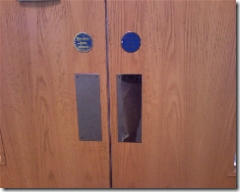 a door which doesn't have any handles, the only thing you can do is push, so that's what you'll do, right?
a door which doesn't have any handles, the only thing you can do is push, so that's what you'll do, right?
To make it a little easier, a good designer would put a plate of some kind on the door, to underline the fact that there isn't a handle for a reason (ie it hasn't fallen off or anything).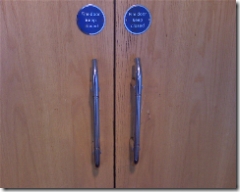
Conversely, when you see a handle, you'll instinctively grab it and pull. So a well designed door will have a handle on the side that needs to be pulled, and nothing (or a plate) on the side that's pushed. The only other marks on these fire doors are signs saying that the door is to be kept closed. Interestingly, they was part of the original Thames Valley Park campus which opened in 1997.
Now if we move to a newer part of the campus, there are nicer-looking glass doors, but their design is less clear - there are handles on both sides which look swish, but offer no affordance - ie they don't give the user any clue which way the door is going to open. Maybe you could look out for hinges or the likes, but it's very common to see people walk up to a door and pull it when they should be pushing.
To try to avoid that confusion, the door company puts a little sign saying "Pull" or "Push" on the door - something that still evades many people's attention, a bit like The Far Side cartoon of the School for the Gifted.
Here are just two examples...
Even the old part of campus has plenty of glass doors, but they are designed correctly. Evidence:
There is nothing on this door other than the furniture - a piece of design which looks good, doesn't have anything superfluous, and yet is easier to use than the more fussily "designed" items.
It's books like DOET which give you a new perspective on the mundane things you'd not normally notice, and as a result, are well worth a good thumb through even if not an exhaustive read.
Comments
- Anonymous
January 01, 2003
(with apologies to Donald Norman, for paraphrasing his excellent book title ) As an IT person, I'm pretty
